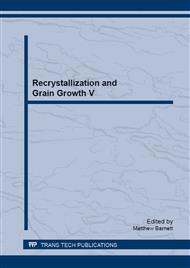p.239
p.243
p.247
p.251
p.257
p.263
p.267
p.271
p.275
Effects of Driving Force and Boundary Migration Velocity on Formation of Recrystallization Texture in Cold Rolled Pure Aluminum Sheets
Abstract:
The effects of net driving force for migration of high angle grain boundaries were emphasized beside many other factors which could influence the process of texture formation during recrystallization annealing of 95% cold rolled pure aluminum sheets. The net driving force consists basically of stored energy. However, it could be reduced by recovery, boundary drag, solute drag and Zener drag in different extents, in which only boundary drag is mis-orientation dependent. It was indicated that both oriented nucleation and oriented growth have obvious influence on recrystallization texture, and how far they influence the texture depends also on the level of net driving force when the grain growth starts during annealing. Oriented growth, which is induced by the differences in boundary drag of differently oriented grains, and the corresponding texture formation, could be observed easily when the recrystallization proceeds under relative higher solute drag and Zener drag in commercial purity aluminum. The oriented nucleation process prevails during recrystallization of sufficiently recovered high purity aluminum with very low solute drag and Zener drag, after which strong cube texture forms. In this case the oriented growth indicates limited effect. Both the oriented growth and oriented nucleation will fail if high purity deformation matrix without clear solute drag and Zener drag has not experienced an obvious recovery before recrystallization grain growth, since extremely high net driving force leads to very small critical nucleus size and multiplicity of growing grains, which results in randomization of recrystallization texture.
Info:
Periodical:
Pages:
257-262
Citation:
Online since:
March 2013
Authors:
Price:
Сopyright:
© 2013 Trans Tech Publications Ltd. All Rights Reserved
Share:
Citation:


